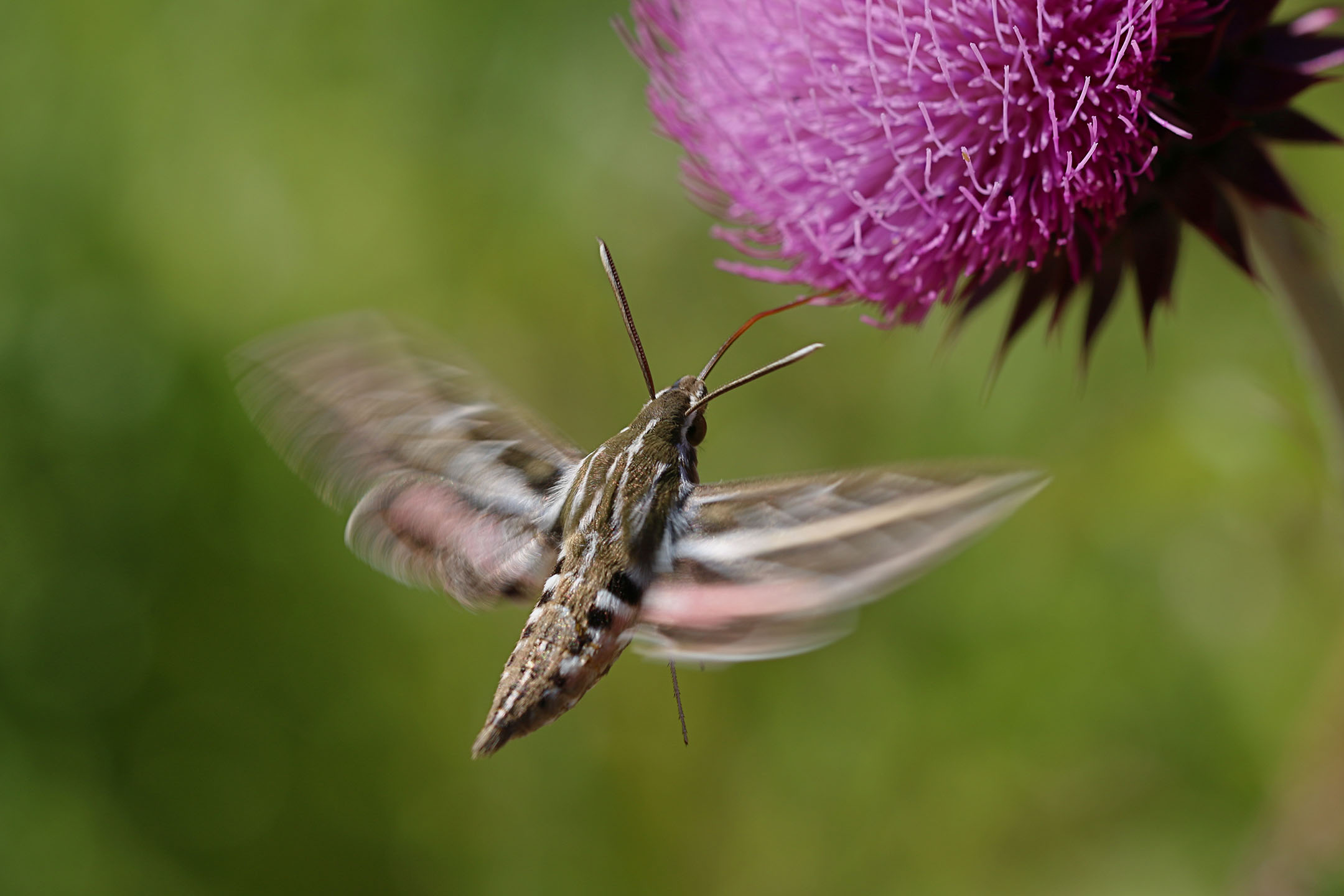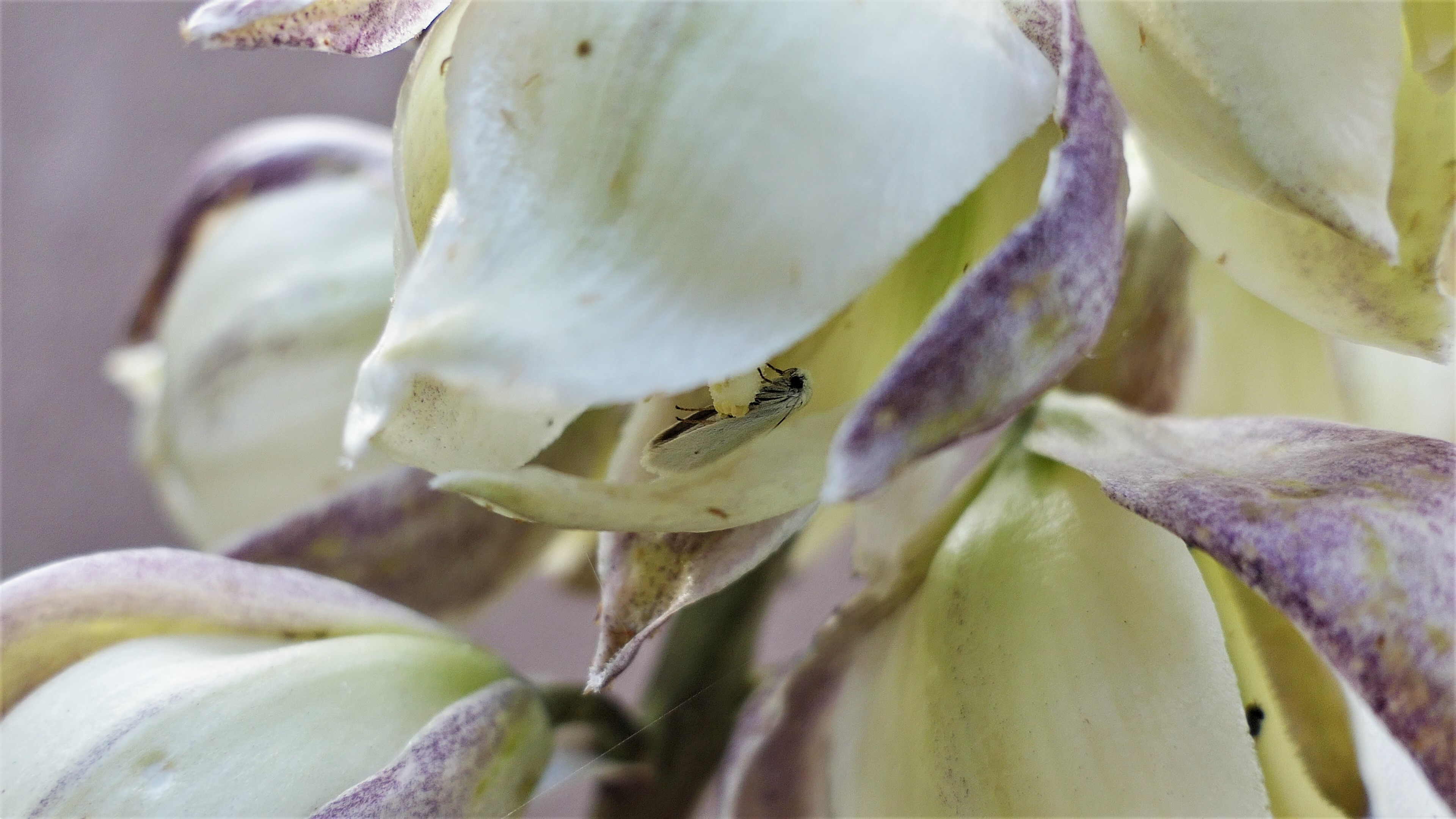The work of pollination is never over—even after dark! While some flowers close when the sun goes down (the technical term for this is floral nyctinasty), most flowers are still accessible at night. When our day-active (diurnal) pollinators turn in for the evening, nocturnal pollinators such as moths, bats, beetles, and even some species of bees take on the night shift to feast on nectar. We are just beginning to understand the importance of these nocturnal flower visitors for pollination of wild and managed plants.
 The white-lined sphinx (Hyles lineata) belongs to a group of moths known as hawk or hummingbird moths, due to their resemblance to hummingbirds in flight. Adults will visit flowers from dusk to dawn, and occasionally can be seen during the day. (Photo: Xerces Society / Stephanie McKnight.)
The white-lined sphinx (Hyles lineata) belongs to a group of moths known as hawk or hummingbird moths, due to their resemblance to hummingbirds in flight. Adults will visit flowers from dusk to dawn, and occasionally can be seen during the day. (Photo: Xerces Society / Stephanie McKnight.)
Pollinator research has largely focused on diurnal pollinators, such as bees and butterflies. Recent research from University College London, however, shows that moths are likely major players in many pollination networks. UCL researchers observed a diverse assemblage of moths transporting pollen from many different plant species under cover of darkness, including some flowers that are not often visited by bees. The study suggested that moths are better at pollinating than previously thought, thanks to their hairy underbellies from where researchers collected pollen samples. Declines in moth populations, combined with a growing understanding of their importance for pollination, highlight the need to include these nocturnal pollinators in pollinator conservation efforts.
Like other pollinators, moths coevolved with plants and now both moths and plants exhibit characteristics that are adapted to each other. The flowers of some plants open in the evening and become more fragrant at night, luring in moths, which depend on scent to find food (and mates). These flowers also tend to be white or pale in color to reflect moonlight, allowing them to be easily seen at a distance by nocturnal pollinators.
Yucca is a wonderful example of an interdependent plant–pollinator relationship: Plants of the genus Yucca are solely pollinated by yucca moths of the genera Tegeticula or Parategeticula, and the caterpillars of those moths feed only on yucca seeds. Amazingly, female yucca moths intentionally pollinate the flowers. They collect pollen from the plant where they mated, fly to a different individual of that yucca species, deposit the pollen, and lay their eggs. The relationship between plants and pollinators is so closely related that many species of yucca plants are reliant on a single species of moth to complete their life cycle and vice versa!
 Hidden inside the creamy-white flowers of the yucca plant, the tiny yucca moth provides an essential link in the life cycle of the plants: it is the flowers' only pollinator. Yucca plants and yucca moths have coevolved to rely entirely on each other. The yucca moth is the only pollinator for the flowers, and the moth caterpillars feed only on yucca seeds. (Photo: Kaitlin Haase.)
Hidden inside the creamy-white flowers of the yucca plant, the tiny yucca moth provides an essential link in the life cycle of the plants: it is the flowers' only pollinator. Yucca plants and yucca moths have coevolved to rely entirely on each other. The yucca moth is the only pollinator for the flowers, and the moth caterpillars feed only on yucca seeds. (Photo: Kaitlin Haase.)
Many moth species, however, visit a variety of different plant species for nectar, most of which have no connection to the plants their caterpillars eat. Some of these flowers are also visited by bees and other pollinators during the day, supplementing the nighttime pollination from moths. Pollen transport by moths may play an important role in facilitating genetic diversity in plant communities across landscapes, as adult moths tend to move much longer distances between patches of plants than bees, which forage around a specific nest location.;
Both day- and night-active pollinators face many threats, including habitat loss, pesticide exposure, disease, and invasive species. But one hazard unique to nocturnal pollinators is light pollution. Artificial lights disorient moths, and research has found this can impair finding mates, evading predators, and pollinating plants. A recent study found that nocturnal visits to plants was reduced by 62 percent in areas with artificial illumination compared to dark areas. Air pollution from the volatile compounds emitted by cars and industrial manufacturing can also interfere with nocturnal pollinators’ scent-based communication. To help conserve moths and other night-active pollinators, keep your garden and other outdoor areas free of unnecessary lighting (information available in English or Spanish), take steps to reduce emission of air pollutants, and consider participating in dark sky initiatives.
.jpg) The yucca moth is smaller than a person's thumbnail, but plays an outsized and largely unseen role in the life of yucca plants. (Photo: Kaitlin Haase.)
The yucca moth is smaller than a person's thumbnail, but plays an outsized and largely unseen role in the life of yucca plants. (Photo: Kaitlin Haase.)
Xerces Heads Southwest: First Stops, Albuquerque and Santa Fe
Supporting more than 1,100 species of bees, the southwestern United States is a pollinator biodiversity hot spot. In addition to an exciting number of bees, the Desert Southwest supports many unique plants and their pollinators, such as cactus bees and yucca moths. This diverse pollinator landscape deserves conservation attention, and Xerces now has a full-time resident staff position in New Mexico—me!
Based in Santa Fe, as Xerces’ Southwest Pollinator Conservation Specialist I am working to create interconnected patches of pollinator habitat in Santa Fe and Albuquerque. Urban habitats can be well-suited for conservation of pollinators, thanks to a concentrated number of gardeners cultivating flowering resources and the ability of many pollinator species to complete their life cycle in a small space.
An essential part of my work is to provide educational resources and trainings on topics such as pollinator biology, native plants for attracting pollinators, and protecting pollinators from pesticides. Due to the coronavirus, most trainings and presentations will take place as online webinar this summer. Xerces is partnering with New Mexico State University to present a multi-week series of webinars that will cover conservation of pollinators and other beneficial insects. These will be recorded and made available on the university’s YouTube channel
In addition, I’ll be presenting a webinar on nocturnal pollinators for Bee City USA – Albuquerque on Saturday, 6/27, Day 4 of its virtual 4th Annual Burque Bee City Pollination Celebration. Hopefully, we’ll be able to feature some live moth guests while presenting outside at night.




